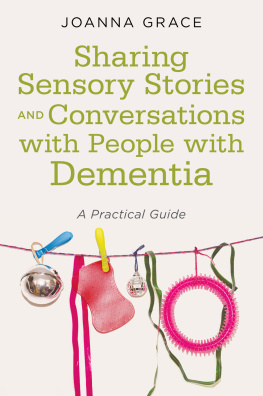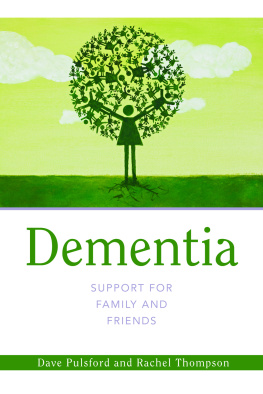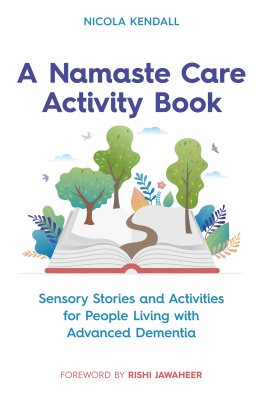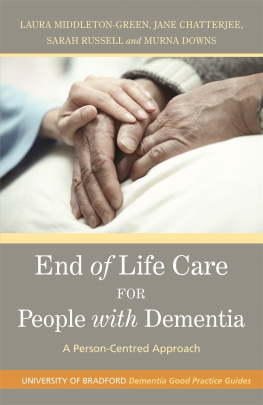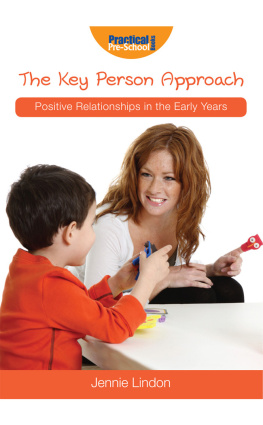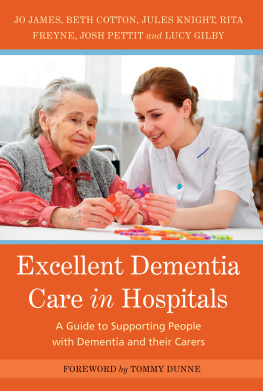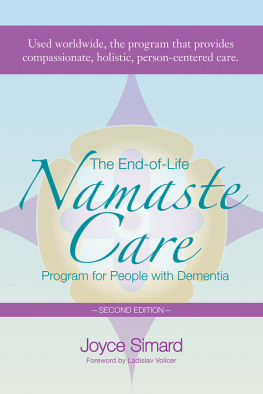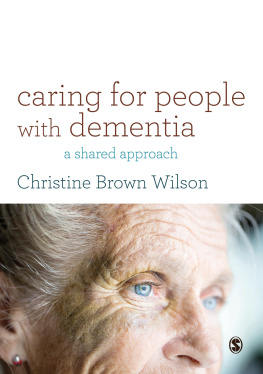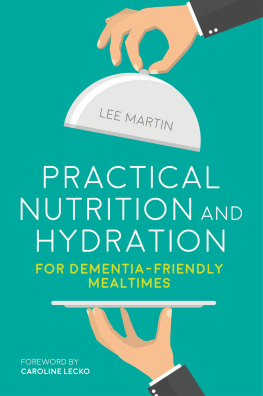
Sharing
Sensory Stories
AND Conversations
with People with
Dementia
A Practical Guide
JOANNA GRACE

Jessica Kingsley Publishers
London and Philadelphia
I see the world more vividly
because I am harvesting the days for you.
Oddities, marvels something beautiful, something strange.
I collect them for you.
And, sharing them, discover them anew.
Pam Brown, b. 1928
Contents
Introduction
Clinical guidelines from NICE (2006) recommend multisensory stimulation for the management of behavioural and psychological symptoms of dementia. Livingston et al. (2014) found sensory interventions significantly improved various forms of agitation. Commentators believe sensory considerations are likely to play a greater role in the care of people with dementia in the future (Behrman et al. 2014).
Clearly the sensory world is one to look into when seeking to better support an individual experiencing dementia, but it can be hard for family members, carers and practitioners to know where to start. The whole world is multisensory; what is the difference between the therapeutic use of sensory experience and a persons day-to-day experience of our multisensory world?
This book begins with the fundamentals of sensory engagement work, before going on to explore how sensory experiences can be used in a supportive and enriching way to enhance the lives of people with dementia. It is a practical guide and at every page turn you will find advice and insight to enable you to put what you are reading into practice.
The book is presented in nine sections; each section (excluding the introduction and conclusion) has an orientation and a summary. These introduce the topics covered in the section and summarise them at the end of each section. These orientations and summaries will help you as you dip in and out of the book according to your needs. You may choose to read through the sections in order, and then refer back using their orientations and summaries to pick out relevant information at a later date, or you may choose to jump sections and read those you feel will be particularly pertinent to your current situation. There is no right or wrong way to read this book, do whatever suits you best.
Here is an at-a-glance guide to what you can expect to find in each section of this book:
Section 1 A note from the author
An invitation from the author to tackle the loss experienced with dementia in a new way.
Section 2 Sensory engagement and its relevance for people with dementia
Here you will find an introduction to the notion of sensory engagement work, insight into what it looks like in practice and explanation of its particular relevance for people with dementia. This section includes information on how sensory engagement strategies can be used to support someone with dementia to feel safe and secure, to minimise their anxieties and to prevent behaviour problems from arising, these important topics are returned to throughout the book.
Section 3 The benefits of sensory stimulation
Sensory stimulation holds benefits for everyone, not just those experiencing dementia. In this chapter you will gain insight into how sensory stimulation supports: cognition, concentration, learning, awareness, a persons ability to engage with another person or an activity, mental wellbeing and memory. There are four case studies demonstrating the use of different sensory strategies in the support of individuals with dementia.
Section 4 Sensory conversations
In order to hold a conversation we need first to be equipped with suitable vocabulary. At the start of this section you will find a guide to seven senses worth of sensory vocabulary. This information will be a precious resource to you as you move on to constructing some of the simple sensory conversations detailed in the latter half of this section, including sensory exchanges, sensory discoveries and sensory sequences.
Section 5 Sensory stories
Sensory stories are a wonderful form of sensory conversation, and so versatile in what they can offer to a person with dementia. In this section you will find all the information you need to create and facilitate your own sensory story, as well as a sensory story, The Gardeners New Grandchild, for you to try straightaway, together with activity ideas to further engagement with the narrative.
Section 6 Sensory support
This section looks at:
how we can use our understanding of sensory vocabulary () to enable a person with dementia to retain their independence when carrying out small tasks, and to support them to engage with an activity, either as a part of a group or independently
how we can use sensory support to set up flight paths to reduce a persons need to express stress through violent means
how sensory engagement strategies can be used to add satisfaction and enjoyment to a persons life, thus contributing to a reduction of occurrences of distress and violence.
Section 7 Sensory environments
This section delves into the wonderful possibilities of sensory environments, looking at how we can create our own small (or not so small) sensory spaces for people with dementia. It also looks at how we can assess everyday spaces and make small sensory adjustments to these so that they are more supportive of people with dementia. At the end of this section we look particularly at how carefully thought-out sensory flight paths can be used to avoid outbreaks of violence and how we can create spaces that promote feelings of safety, both for individuals with dementia and for those who care for them.
Section 8 Sensory support for mental wellbeing
The way we facilitate sensory experiences, especially some of the simplest ones, can have a profound impact on a persons mental wellbeing. Making informed choices between sensory experiences can provide opportunities to support a persons mental wellbeing. considers the impact of sensory engagement on mental wellbeing by exploring five concepts that underpin experiences of mental ill health: engagement, time, change, agency and self. We look at how each can be addressed through simple sensory conversations.
Section 9 Conclusion
We conclude by drawing together all the insights we have shared, and showing how through sensory engagement and conversations, we may continue to maintain a meaningful connection with a loved one throughout their journey with dementia.
Contributors
Coralie Oddy Reminisense remini-sense.com
Becky Lyddon Sensory Spectacle www.sensoryspectacle.co.uk
Nina Ockenden-Powell Wild Happy Well wildhappywell.com
Doug Melia Safer Handling www.safer-handling.co.uk
Katie Rose White The Best Medicine thebestmedicine.co.uk
Section 1
A note from the author
My background as a sensory engagement specialist has primarily been within education and adult care settings. Much of my work has been focused on the life experiences of people with profound disabilities. Often the people I work with have been considered incapable of communicating and learning. My role has been to show how sensory strategies can be used to foster engagement and to facilitate progress which, no matter how small the steps forwards, is always valuable.
Since 2013 my work has also come to encompass the community of people experiencing dementia. As I have carried out this work and (more strikingly, to me) as I have written this book, I have felt the difference between this community and the community of people with profound disabilities. Where I have been used to talking about small steps forwards for people with profound disabilities, with people with dementia we are almost always looking at small steps backwards: skills being lost not gained, and the maintenance of skills, rather than the acquisition of new ones, being the highest aim.
Next page
